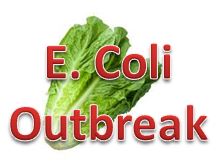E. coli in Romaine Lettuce-Impact of No Recall and Potential Solution
The E. coli Outbreak
 Earlier we reported that an E. coli O157:H7 outbreak in the US was suspected of being related to an outbreak in Canada that had been linked to romaine lettuce. From November 15 to December 17 illnesses in 13 states were reported. Five people have been hospitalized, two have developed hemolytic uremic syndrome (HUS), and one person died.
Earlier we reported that an E. coli O157:H7 outbreak in the US was suspected of being related to an outbreak in Canada that had been linked to romaine lettuce. From November 15 to December 17 illnesses in 13 states were reported. Five people have been hospitalized, two have developed hemolytic uremic syndrome (HUS), and one person died.
The Canadian Health Authorities reported on 41 cases of illnesses in 5 Eastern states (Ontario (8), Quebec (14), New Brunswick (5), Nova Scotia (1), and Newfoundland and Labrador (13)) attributed to E. coli O157:H7 in romaine lettuce. Seventeen individuals have been hospitalized. One individual died.
As a result of their investigation, the Canadian Health authorities recommended the people in the Eastern provinces to refrain from eating romaine lettuce.
The CDC reported that the E. coli causing the illnesses in both countries was genetically closely related. This closeness implies that the illnesses are sharing a common source of infection. However, the CDC has not yet identified the source of the US infection.
In the U.S. there is no recall of romaine lettuce or a recommendation to stop its consumption. In a statement Brittany Behm, MPH, a CDC spokeswoman said in an email that “there is not enough epidemiologic or traceback evidence at this time to indicate a specific source of illnesses in the United States. Therefore, CDC cannot recommend that U.S. residents avoid a particular food.” The CDC believes that the evidence collected to date does not have sufficient convincing information linking the lettuce to the illnesses. “We strive to be fast and right. … We wish we knew more and we’re working hard to get there. But we don’t have enough evidence yet,” said Wiliams, chief of the CDC’s Outbreak Response and Prevention Branch. He also said that there was no guarantee that in the future, the CDC and FDA would be able to identify the exact source of the outbreak.
Consumer Report Recommendation
The consumer Report magazine has taken an extreme step advising the public to stop the consumption of any romaine lettuce until there is a clarification of the situation.

“Even though we can’t say with 100 percent certainty that romaine lettuce is the cause of the E. coli outbreak in the U.S., a greater degree of caution is appropriate given that lettuce is almost always consumed raw,” said James Rogers, the Consumer Report’s director of food safety and research.
Jean Halloran, the director of food policy initiatives at Consumers Union, said:” Better to avoid romaine lettuce for now.” “Given the size of the outbreak and the severity of the risk, which is worse for elderly people and children, the magazine felt it was the right decision,”.
Bill Marler, a Seattle-based attorney specializing in food safety cases noted that “Identifying the source of a foodborne illness outbreak can be a delicate balance between warning consumers of public health risks and unduly tainting industries or specific businesses without sufficient evidence.” However, he supports the Consumer Report decision to advise people not to consume romaine lettuce.
The consumer Report recommendation was intensely covered by the many TV outlets and in many of the papers.
“To Recall or Not” and Their Consequences
The Office of Inspector General (OIG) of the U.S. Department of Health and Human Services issued a recent report concluding that the current recall process used by the FDA can be too slow putting consumers at risk. In response to the report, the FDA is planning to announce a new strategic plan in place to outline actions to improve the recall management. A faster process if clearly needed.
With the requirement to definitively decide the source of the outbreak, the investigation sometimes takes a very long time, and meanwhile, the products are being consumed, and people get ill.
The heavily publicized recommendation by the Consumer Report will certainly cause many good lettuces to be disposed of. Growers of perfectly health romaine lettuce will suffer. Currently, all romaine lettuce is presumed guilty of contamination. A better system should be put in place to make the identification of contaminated produce easier.
On Jan. 6, the United Fresh Produce Association e-mailed members, stressing that the last U.S. case was reported Dec. 8; the last case in Canada was Dec. 12. “This fact makes it very unlikely — even if the outbreak is tied to romaine —that any affected product remains in marketing channels,” therefore in their opinion the outbreak is over.
However, Bill Marler wrote “I certainly understand that many romaine lettuce growers would like the CDC to call the “outbreak over” since lettuce is perishable. Since neither Canada nor the US has been able to confirm where the contamination occurred – on the farm, in processing, in transit – I think I agree with the Canadian and Consumer Reports approach – “When in doubt, throw it out.”
Is Blockchain the Solution
As reported earlier Blockchain is a decentralized, shared log of data maintained on a network of computers. It is an exciting new technology that can revolutionize food safety and offer much faster traceability of food products including produce.

According to Fortune magazineViant and the World Wild Fund for Nature, using blockchain technology, provided a way to verify the fish journey from the ocean to the plate. The Tuna fish is tagged with a QR code (two-dimensional barcode) supplied by Viant. The fish is logged into the blockchain system, and its progress is monitored throughout the chain.
It is conceivable that in the future lettuce can be tagged with a QR barcode and be followed to the markets. As a result, any outbreak will be easier to trace back to the farm of origin.
